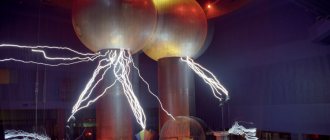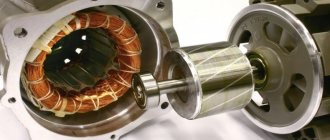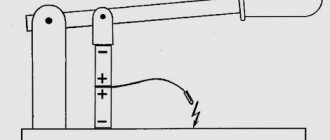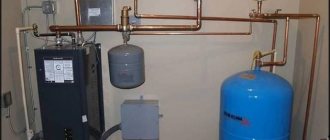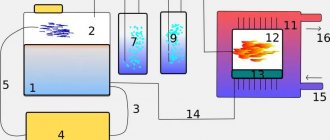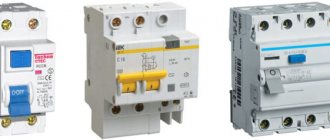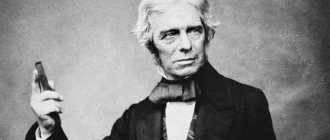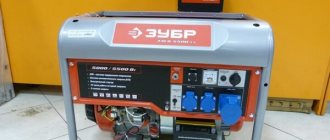Kitchen appliances, pumping stations, heating systems and many other household appliances require uninterrupted power supply. In the event of a power outage, only a special gasoline electric current generator for a private home can help. Let's look at what this device is, what parts it consists of and how it works, what types of it can be bought today, what criteria should be used to make a choice, as well as how to correctly calculate the power and what stages the procedure for starting it consists of.
Generator for a private home Source optoweek.com.ua
When is a home generator useful?
Electric generators are most often used in emergency situations. When the power supply to the site is interrupted, it is enough to remove this unit from the garage and start it to temporarily restore the power supply.
Many people consider such a device to be an unnecessary luxury. However, in populated areas where the power supply is often interrupted or during an emergency, a generator can help out.
Principle of operation
An electric generator is a device for generating electricity. It can be used to power electrical devices.
- An electric generator can power devices in a private home during a power outage.
- However, it can also be successfully used where it will be an independent source of electricity.
- Such places would be, for example, a garage, workshop, garden or construction site.
Fuel type
The generator sets available in the market are most often equipped with an internal combustion engine. Some models can also run on liquefied or natural gas.
A petrol engine, like a car, may perform slightly better, but is theoretically less durable if the unit is used intensively.
When choosing a generator, you should also pay attention to the capacity of the fuel tank. It is related to working hours. It is also worth checking whether the generator has a fuel level sensor and a catalytic converter to reduce exhaust emissions.
Diesel type units
They are a more economical and reliable type of equipment compared to the previous version. Diesel generators are used if the absence of light in the house is long - more than 8 hours. The cooling system (air and liquid) allows them to be used as household mini-power plants.
Household air-cooled diesel fuel generators have only one advantage over gasoline units - a longer duration of simultaneous operation, but at the same time they will take up a lot of space and be noisy.
- How to choose a piston compressor
- In what cases is washing machine repair needed, what should everyone know?
- Do-it-yourself wood splitter - drawings, diagrams, dimensions. 120 photos of homemade wood splitters
But the service life of liquid-cooled diesel generators reaches 40 thousand hours. This ensures the reliability of the equipment. You can purchase models with motors at low speeds - 750 and 1.5 thousand rpm. They make less noise and save fuel.
Generators with 3 thousand rpm are also available. With a low price and compactness, this option will be more expensive during operation.
Among the advantages of diesel generators it is worth highlighting:
- higher MTBF;
- total efficiency in electricity generation;
- possibility of round-the-clock use in mini-power station mode;
- safety in terms of fire safety parameters.
But such models also have serious drawbacks. Firstly, they are not used at low temperatures less than -5 degrees without special thermal protection. Secondly, there is noise during operation. Thirdly, careful care is required during use. For example, if you bought a diesel unit, but you do not use it often or it idles, then the wear and tear can be significant.
In general, the option under consideration is a fairly effective way to solve the problem of autonomous power supply to a private home.
Generators with internal combustion engines
The most commonly used generators are powered by gasoline or diesel internal combustion engines.
The power of the unit depends on the engine size. It is better to choose a place for them where the engine noise will not bother you. It is desirable that it have a roof.
Alternating current generator device
So, regarding the design of the alternator and the principle of its operation.
The most widespread are alternating current generators with a fixed conductor. This is due to the fact that the excitation current in relation to the current received from the generator is small. If you look at the picture, you will see two rings through which the excitation winding current flows and this is the weak link of any generator with an excitation winding. That is, either we supply a small excitation current through the rings through the brushes, or we remove a large operating current through the rings. In electricity, the stationary part of generators or motors that contains the winding is called the stator. The moving part may be called a rotor or armature.
Main types of alternating current generators
There are quite a few types of generators. Let's try to classify them according to their main areas.
- By type of energy used:
- Wind energy
- Liquid fuel energy
- Heat energy
- Water energy
Gas energy
- Single phase
Three-phase
There are other types, but they are less common.
- By type of excitation:
- Independent arousal. In this case, on the same shaft with the alternating current generator there is also a direct current generator, which powers only the excitation winding. In this case, excitation can be performed by any other current source, for example, a battery.
- Excitation using magnets that are located on the stator or armature, which greatly simplifies the design of the generator, but using this method it will not be possible to obtain powerful generators.
Self-excitation. In this case, the voltage for the field winding is obtained directly from the generator used.
Synchronous generator: circuit, device, principle of operation
What does synchronous mean in relation to a motor or generator? To put it very simply, the frequency of alternating current strictly depends on the rotation speed of the rotor of the electric machine and vice versa. In this way, the frequency of the alternating current can be controlled relatively easily. The synchronous generator itself has a number of advantages, thanks to which it has become the most widespread. I’ll tell you a big secret, it is synchronous generators that are used at all stations where electricity is produced.
The drive motor (designated as PD in the diagram) can be any rotating device: engine, turbine, windmill or water wheel impeller. On the same shaft with the PD there is a generator rotor with an excitation winding. A constant voltage is applied to the winding and a magnetic field is formed around the winding. When the rotor rotates, an EMF appears in the stator windings, that is, a voltage appears, only now variable, the frequency of which depends on the rotation speed of the rotor n1 and the number of pole pairs p. The EMF frequency can be calculated using the formula.
Asynchronous generator: circuit, device, principle of operation
Asynchronous generator device
An asynchronous generator is essentially an asynchronous motor. That is, any asynchronous motor can be switched to energy generation mode and vice versa. Structurally, the device, which is called a generator, is designed in such a way as to have good cooling. We will not dwell deeply on the principle of operation of asynchronous machines, but I will briefly tell you why they are called asynchronous using the example of a motor.
When voltage is applied to the stator windings, a magnetic field is formed; for three-phase motors it is circular, for single-phase motors it is ellipsoidal, tending to be circular. The magnetic field begins to cross the turns of the stator winding. In the short-circuited winding of the rotor, an EMF arises, that is, voltage, and since the winding is short-circuited, a current begins to flow through it, which also creates a magnetic field. The interaction of these magnetic fields causes the rotor to move. What will happen if the speed of the rotor becomes equal to the speed of the magnetic field created by the stator? That's right, the stator magnetic field will stop crossing the rotor winding. This can be compared to two cars moving at the same speed. The cars seem to be moving, but at the same time, in relation to each other, they seem to be standing still, the ground is simply rushing under the cars at high speed. So, as soon as the rotor speed and the speed of the stator magnetic field become the same, EMF will no longer be generated in the rotor winding, the interaction of the magnetic fields of the stator and rotor will stop, and the rotor will begin to stop. Therefore, the rotation speed of the rotor of an asynchronous motor is always slightly less than the rotation speed of the stator magnetic field, and this value is called slip.
So, in order for an asynchronous motor to become a generator, it is necessary to determine the slip and increase the rotor speed by this amount. Let's say we have a single-pole three-phase asynchronous motor with a shaft rotation speed of 2800 rpm. If such a motor were synchronous, the rotation speed would be 3000 rpm. That is, the sliding is 200 revolutions per minute. This means that if we start rotating the rotor at a speed of 3200 rpm, the engine will switch to generator mode and will no longer consume, but generate EMF.
The difficulty of using such generators is that they are prone to failure. For example, if you turn on a resistive load (incandescent light bulb or heater), the inrush current will be small. Significant overload will not occur and the generator will operate stably. If you turn on a reactive load, for example, an engine, then there will be a large starting current, 5-20 times higher than the rated current, which will “fail” the generator, that is, cause a sharp drop in voltage on the generator windings. After such a failure, the asynchronous generator must be excited again. So, the simplicity of an asynchronous generator is outweighed by a serious drawback.
Well, you also need a capacitor unit to excite the short-circuited rotor winding. If we choose the wrong capacitance of the capacitors, then in case of “undersupply” from the generator we will receive less current, and in case of “oversupply”, our generator will overheat greatly.
Connection diagrams
Actually, not even switching schemes, but options. There are usually three of them:
- Automatic switching on . In this case, a special emergency switching unit is installed. As soon as the voltage in the network is turned off, the unit sends a command to start the generator and switches the network from an external power source to the generator set.
- Manual activation . In this case, the user himself carries out the switching operation from the external power source to the generator set and manually starts the generator.
- Synchronous work . This mode is mainly used at large stations, the generators of which are combined into one network. All generators of this network operate synchronously, with the same frequency, with the same phase order and with the same voltage on the stator windings.
Single phase generator
I won't go into detail here. Such devices can now be found in any tool store. If a single-phase generator is used as a backup source of electricity, it is connected to the home network, usually through a switch. That is, an external power source and a generator cannot operate on the same network at the same time - it’s either one or the other. Firstly, there is no need, and secondly, it would greatly complicate and increase the cost of household generators. The only thing I can focus on here is connecting a single-phase generator to a three-phase network.
Connecting a single-phase generator to a three-phase network
However, this method has its drawback. Three-phase motors will not work in such a network; if you turn them on, they will heat up very quickly and fail.
Three phase generator
Three-phase generators can be domestic and industrial. The design of a three-phase current generator in the household version is practically no different from a single-phase one, as is the switching circuit. The only condition when connecting a household generator to a network, if there are three-phase motors in such a network, is to observe the phase order. If the load in the house is single-phase, then this precaution can be neglected.
The industrial version of a three-phase current generator device is a device equipped with an automatic start and can sometimes be equipped with a synchronization device. It is better to entrust the connection of such generators to specialists.
Well, a household generator, just like a single-phase generator, is connected to the network through a switch. Consequently, depending on the position of the switch, either an external power source or a generator operates.
Single and three phase units
Single-phase generators require a voltage of 1~230V. These are low power devices. They are primarily suitable for household appliances. In turn, three-phase generators 3~400V are suitable for high-power equipment. These are mainly electric heating, hydrophore installations, water heaters, and so on.
- Before choosing a generator, it is also good to check what type of electricity the power comes from.
- There is also a more universal device - a three-phase generator, which also allows you to connect single-phase devices (it has 2 sets of sockets).
- However, such a unit should be used according to certain rules. The current power consumed from single-phase sockets cannot exceed 60% of the power of the entire generator.
- You should also ensure that when simultaneously supplying single-phase and three-phase loads, the phases are loaded more or less evenly.
The more powerful the generator, the more appliances you can power from it at the same time, but also the more money and space you will have to spend on it. Some models are very large. This is especially noticeable in the photo of a generator for the home.
The best gasoline generators
The generator is an indispensable unit when the centralized power supply is cut off. It can act as an alternative and main source of energy for various equipment. To choose the best generator, there are several models to consider. The rating includes five gasoline generators that are in demand among buyers.
Hyter DY6500L
Gasoline generator with a power of 5.5 kW and a voltage of 220 V. Used for domestic purposes, to power construction equipment and lighting systems.
Due to its high power, it is suitable for use in tourist camps and places where there is no possibility of a centralized power supply.
Due to the durable steel case, it is protected from damage due to mechanical impact.
The device operates from one refill up to 10 hours. For ease of movement, the model is equipped with a tubular frame.
Characteristics:
- engine power - 13 hp;
- tank volume - 22 l;
- fuel consumption - 374 g/kW*h;
- size - 690x550x540 mm;
- generator weight - 70 kg;
- noise level - 71 dB.
Advantages:
- high-quality assembly;
- easy operation;
- trouble-free operation;
- quick start.
Flaws:
- lack of wheels;
- fragile starter.
Hyundai HHY 3020F
A practical device for country houses, construction sites and outdoor events . Due to the power of 3.2 kW, the device ensures stable operation of electrical appliances and at the same time consumes a minimum amount of fuel.
The model weighs only 44 kg and is compact in size, making it easy to transport. The noise level is 69 dB.
The model is equipped with two sockets for connecting equipment.
The device starts manually and runs on gasoline for up to 15 hours due to the large tank.
Characteristics:
- engine power - 7 hp;
- tank volume - 15 l;
- size - 610x510x480 mm;
- generator weight - 44 kg;
- noise level - 69 dB.
Advantages:
- easy to use;
- affordable price;
- quick start;
- uninterrupted operation.
Flaws:
- long start-up in cold weather;
- no wheels.
CHAMPION GG6500
Affordable technology that is reliable and easy to use . Provides power to household devices and equipment for repair work.
Due to the large fuel tank and powerful four-stroke engine, it does its job perfectly.
Can act as a mobile station and emergency power supply.
The model is equipped with a machine to protect the engine from overloads, as well as an oil level sensor with automatic engine shutdown.
Characteristics:
- engine power - 16 hp;
- engine speed - 3600;
- tank volume - 25 l;
- fuel consumption - 2.5 l/h;
- generator weight - 72 kg;
- noise - 97 dB.
Advantages:
- launch in any weather;
- stable voltage at any load up to 5 kW;
- low fuel consumption;
- affordable price;
- long work without refueling.
Flaws:
- plastic case;
- noisy work.
Hyundai HHY 3020FE
Affordable semi-professional generator . It is easy and safe to use. Due to the capacious tank and powerful engine, it ensures stable operation of household and construction electrical appliances.
Suitable as a backup and main source of power supply.
The generator is equipped with a circuit breaker to protect the engine from heating and overload. The oil level sensor automatically turns off the engine when the fuel level is critically low.
Characteristics:
- engine power - 7 hp;
- tank volume - 15 l;
- size - 610x510x480 mm;
- generator weight - 49 kg;
- noise level - 69 dB.
Advantages:
- high-quality assembly;
- low fuel consumption;
- large fuel tank;
- simple operation and maintenance;
- reliable brand.
Flaws:
- noisy work;
- no autostart system.
Fubag BS 6600
The gasoline generator has a laconic design and is distinguished by powerful characteristics . Thanks to the 13.8 horsepower engine, it ensures stable operation of household and construction electrical appliances.
The unit weighs 87 kg, so it is better to use road transport for transportation.
The model is equipped with an electric starter, which simplifies its use.
The presence of a cooling system eliminates the risk of engine overheating.
The voltage stabilizer prevents damage to the device. The kit includes keys for disassembling and servicing the generator.
Characteristics:
- engine power - 13.8 hp;
- tank volume - 25 l;
- fuel consumption - 3.3 l/h;
- size - 700x580x540 mm;
- generator weight - 84 kg;
- noise level - 98 dB.
Advantages:
- presence of an electric starter;
- quick start even in cold weather;
- powerful battery;
- powering a large amount of equipment.
Flaws:
- noisy work;
- release of a large amount of heat.
Generator types
A home generator produces power in a single-phase system, but three-phase generators can also be found.
Another criterion is the type of fuel used and the power generated by the device. The cheapest units are those with a two-stroke engine running on a mixture of gasoline and oil in certain proportions. Unfortunately, they are not very economical and are quite loud.
The best choice is a generator with a four-stroke internal combustion engine.
The least common devices on the market are natural gas generators.
- Their main advantage is that they can be powered from gas cylinders, so they are often used as an emergency power source on sites.
- Unfortunately, the gas itself is ineffective and burns strongly while the device is operating.
- However, if you need a very efficient generator that will be used frequently, you may want to look at a diesel generator.
Gasoline models
Generators differ primarily in the type of fuel used in their operation. The most popular are gasoline models. They are quite affordable, have a compact size and operate with an acceptable noise level.
At the same time, most products in the economy class line have a high level of fuel consumption, which is more expensive compared to analogues.
Gasoline units require A-92/A-95 fuel to operate. Approximate power up to 15 kVA. But you won’t be able to use them for a long time, so connecting them as the only source of power supply is unacceptable.
The longest operating time without switching off is 8 hours. A pause in operation is required for effective cooling of the entire system.
When choosing this option, you need to determine which type of engine is right for you. If the two-stroke version has a performance oriented towards powering installations up to 0.9 kVA, then the four-stroke model allows limits for this indicator of 1-15 kVA.
The material of the cylinder block affects the service life of the equipment:
- for aluminum blocks - 500 hours, which is enough to cover short-term electricity needs;
- cylinders with a cast iron liner have a service life of up to 1500 hours.
A gasoline generator can have a four-stroke engine with quieter operation and a longer service life.
There are two possible types of its design:
- single-cylinder with a service life of 2.5-4 thousand hours;
- two-cylinder with the ability to operate up to 5 thousand hours.
The main advantages of this type of generator are ease of use, compactness and the ability to start in harsh conditions at temperatures down to -30 degrees. Its relative low cost and low noise level make it an excellent solution for compensating for short-term power outages.
Don't forget about the shortcomings. These are the high cost of fuel, storage restrictions of no more than six months, explosion and fire hazard.
Number of connected devices
In order for the energy generator to fulfill its task, its power must be greater than the total power of the devices that will be connected to it.
Rated (not maximum) power is important, especially when it is necessary to power devices with asynchronous motors that require high current, such as pumps or hydrophores.
- When determining the power of an electric generator for a home, you should add up the power of all the devices that you plan to power.
- It should be 70-80% of the generator power. However, this indicator may vary depending on the generator itself and the connected devices.
- It is worth studying this topic in more detail before purchasing.
- Typically, 1.2 kW is added to the power consumption of each device. The power reserve should be 20-30%.
- Otherwise, the power consumption may be too high and you will have to turn off several devices.
It is better not to connect single-phase and three-phase devices to a three-phase generator at the same time.
Also, if necessary, you can buy a generator for your home with automatic start.
How to correctly calculate the required power
The price of equipment for autonomous power supply to a home is directly dependent on its power. Different houses have electrical equipment with their own energy consumption parameters.
If you plan to achieve complete independence, then you will need to power the entire house, which means you need to sum up the power of all the equipment. In this case, you will need a generator with a power of at least 10 kW.
Well, if you rarely visit your dacha or the lights are turned off only periodically, then it is more advisable to connect only vital devices. Then the power of, for example, a conventional generator with auto-start, 3-5 kW, will be sufficient.
It is easy to calculate the required power. It is necessary to study the passports of the devices and summarize the indicators. But remember that a number of units with electric motors, such as a refrigerator or a pump, have a starting power that can be 3-5 times higher than the rated one.
Some manufacturers indicate power consumption in kVA. To convert to kW, this value must be multiplied by a factor of 0.8. Well, be sure to provide a reserve of 10-20% when calculating the total power.
The quieter the better
Which generator is best for home? There is no clear answer to this question. But another important parameter when choosing a device is the level of noise it creates, which is indicated in the specification.
If the generator is located outside the building, then the volume can still be tolerated.
- The situation is different, for example, in a garage. Unfortunately, most generators available on the market make a lot of noise, reaching levels of 90-98 dB during operation.
- For comparison, a passing motorcycle produces 95 dB.
- However, there are models of built-in units (unfortunately, correspondingly more expensive), in which the noise level is reduced to 65–75 dB (vacuum cleaner - 70 dB).
DC generator device
To find out what a DC generator is, its structure and principle of operation, let’s go back a little. We have already figured out how an alternator works. Let's take a closer look at the process of EMF generation. As the rotor rotates, we have a cycle equal to one revolution of the rotor, or 360°. Let's find out what happens in this cycle:
- 0° - EMF =0
- 90° - EMF reaches its maximum value with the “+” sign
- 180° - EMF is again 0
- 270° - EMF reaches a peak value with a “-” sign
How to make sure that the polarity of the voltage does not change? Great minds came up with the following idea - to use a collector, that is, to remove voltage only of the required polarity. Remember, we said that in an alternating current generator, the stator winding is the working one, and the excitation winding is located on the rotor. So, in a DC generator, voltage is removed only from the rotor, which is called the armature.
DC generator circuit
If such a generator has only one pair of poles, as in the picture, then we will get a pulsating direct voltage, where the frequency will be twice the rotation speed. That is, if the rotation speed is 50 revolutions per second, then the pulsation frequency will be 100 Hz. To reduce voltage ripple, increase the number of pole pairs.
Since the invention of the DC generator, it has remained virtually unchanged schematically and in principle of operation, only the manufacturing technology has changed and now it looks like this:
Main types of DC generators
Currently, commutatorless DC motors are gaining popularity. Is a brushless generator option possible? Unfortunately, we have not yet been able to solve this problem. So, if you see the name “Brushless DC Generator” somewhere, know that it is an AC generator with a rectifier unit.
For this reason, DC generators are characterized only by the type of excitation:
- Generators excited by magnets . Such generators cannot develop high power, so they are used only where small power is required. And, of course, the use of magnets significantly reduces the cost of such generators.
- Independent arousal. In the same way as with alternating current generators, an external power source not connected to the generator is used for excitation.
- Dependent arousal, which is divided into three types:
- Parallel excitation. As the name suggests, the excitation winding in such a generator is connected in parallel to the armature winding. Sometimes this type of excitation is called shunt.
- Consistent excitation. Here the excitation winding is connected like a garland, in series with the armature winding. This type is sometimes called serial.
- Mixed or compound excitation. The excitation winding of such generators consists of two parts, the first is connected by a shunt method, the second by a serial method.
Generators with independent excitation: circuit, device, principle of operation
Independent excitation generator circuit
The operating principle of this generator is quite simple. However, the simplicity of the generator is also its disadvantage - it requires an external independent power source. The generator armature is accelerated to the required speed, then the generator is excited using a rheostat. An EMF appears on the armature windings and when a load is connected, current begins to flow.
The load capacity of such a generator is very good. As a rule, the difference between the no-load voltage, when the load is not connected, and the voltage at the rated load of the generator, when the consumer is fully loading, is only 5-10%.
The advantage of a generator with independent excitation is that it can be started under load, that is, with electrical appliances connected.
Generators with parallel excitation: circuit, device, principle of operation
Parallel excitation generator circuit
A generator with a parallel connection of the excitation winding, in principle, also has good load characteristics, although somewhat worse than those of circuits with independent excitation - 10-30%. Circuits with dependent excitation have one feature: in order for excitation to occur, the metal of the generator must have residual magnetization. 2-3% of residual magnetization is enough to start the self-excitation process. Of course, in this case the direction of the excitation winding must coincide with the direction of the residual magnetization field.
The generator armature is spun up to rated speed, due to residual magnetization self-excitation occurs, that is, an EMF appears in the generator-excitation winding circuit and a small current appears. It increases the EMF, therefore the current increases again and this happens until a balance is reached between the voltage drop in the generator winding and the voltage drop in the field winding.
There is one peculiarity in the operation of the generator. If you gradually increase the load until a short circuit occurs, then at some point the generator power will reach peak values, then begin to decline. In fact, if you create a short circuit at the moment of nominal load of the generator, then nothing bad will happen. But if this is done with a small load, then the short circuit current reaches critical values of 8-10 In, which means that such generators are highly recommended to be protected from short circuits by any available method.
Such generators are most widespread because they do not require external power supplies, have good load capacity and allow control of the excitation current.
Generators with sequential excitation: circuit, device, principle of operation
Series excitation generator circuit
Since the current of the excitation winding in this case is equal to the current in the circuit, and therefore reaches large values, the excitation winding is made of thick wire and has fewer turns than in the previous two circuits. The operating principle is the same as the previous scheme. The winding and the residual magnetization field must coincide in direction. When the armature is untwisted to the rated frequency, an EMF occurs, the current rises and further increases until balance is achieved.
But there is one small nuance here. The field winding current varies depending on the load current, and there is no way to regulate the field current. And this leads to the fact that the voltage also changes greatly. Here we get a real current generator, not a voltage generator. That is why the scope of application of a generator with series excitation is very limited.



